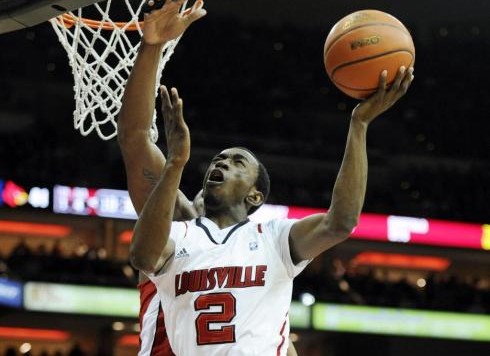Despite the fact that conference play has started in most leagues and we now have at least a dozen games upon which to evaluate each team, there are still some squads I can’t get a great read on. Over the coming weeks, my plan is to take a closer look at these teams in an attempt to formulate an opinion one way or the other.
The first team I wanted to break down is
As it stands,
In looking at their advanced stats, a few things stand out. First, this does have the makings of a solid defensive team. They rank sixth in adjusted efficiency, 10th in TO%, and 13th in eFG%. As you might expect, they also rank high in steal and block percentages, and this overall aggressiveness on defense leads to a relatively high FT Rate against them. Three players (Russ Smith, Rakeem Buckles, and Elisha Justice) currently average over 5.0 fouls per 40 minutes, and two others have at least 4.0 FC/40.
One trend working against them is that their opponents have shot just 62.6 percent from the free throw line, which is 15th-worst in the country. That should normalize as the season rolls along.
Through 14 games, the Cardinals have allowed just two opponents (
All that being said, I’m willing to concede this is a solid team defensively that bears a number of statistical similarities to last season’s squad, which finished fourth in adjusted efficiency.
However, the offensive numbers are worse than last year, and the team ranks in the Top 100 in just one of the four factors. That bright spot is OReb% where they are currently grabbing 37.4% of their misses, although their numbers were well below that in their two losses.
The biggest black eye on their profile is their 48.1 eFG%, which ranks just outside the Top 200. While a 31.4 percent success rate from three-point range is a driving factor, their 48.6 percent shooting on two-pointers ranks just 138th. Russ Smith is second on the team in scoring (12.3 ppg), and his 35.6 shot percentage is crazy. He’s making 36.7 percent from deep but just 40 percent from inside the arc. Smith is exciting to watch but a textbook volume shooter.
Chris Smith is leading the team at 39.2 percent from long range, which is relatively close to his clip from last season. However, Kyle Kuric’s three-point shooting has dipped from 44.9 percent last year to 34.2 percent this season. For a guy who takes more than half of his shots from deep, that has to change, but since he shot 36.0 percent as a sophomore, last season’s gaudy numbers are starting to look like the anomaly. Interestingly enough, the 6-foot-4 Kuric is leading the team in two-point shooting with 64.2 percent. Peyton Siva is shooting just 18.9 percent from deep, and freshman Chane Behanan has taken nearly 20 percent of his shots from deep, making just 3-of-18 from three-point land.
For a team shooting the ball poorly, they can’t afford to compound empty possessions by turning the ball over. So far, the Cardinals are in the middle of the pack with a 20.5 TO%. Siva’s 27.9 TO% is up slightly from last season, while Rakeem Buckles continues to be a turnover liability.
Individually, just three players have ORtg’s over 100.3 while four are under 95.0. Their three most efficient players (Chris Smith, Kuric, and Gorgui Dieng) all have usage rates of 18.3 or less, while the trio with the highest usage rates (Russ Smith, Siva, and Behanan) have subpar ORtg’s based largely upon their shooting percentages. That being said, each of those guys is incredibly important to the team. Russ Smith is second in the country in steal percentage and has a solid assist rate in addition to his ability to draw fouls. Siva has a gaudy assist rate and can wreak havoc on the defensive end, and Behanan boasts terrific rebounding percentages on both ends, draws fouls, and blocks shots.

One guy who has continued to improve is Dieng. He’s shooting 55.6 percent from the field and ranks in the Top 30 in both block percentage and OReb%, while also posting solid numbers on the defensive glass. Dieng also has a 50.5 FT Rate, although he has made just 64 percent from the stripe. Turnovers are a slight concern, but the numbers suggest the Cardinals would be well served to give Dieng additional touches on the offensive end, particularly as his game continues to evolve.
Another player who can help the Cardinals offensively is freshman Wayne Blackshear, who was recently cleared to begin individual workouts after injuring his shoulder prior to the start of the season. His ability would give their offense another dimension, so while I don’t think this team is anywhere near elite offensively, there is room for improvement.
When looking for a comparison from recent years in terms of efficiency numbers, Louisville looks a lot like last season’s
Given the upcoming schedule, it’s likely
Follow me on Twitter (@AndyBottoms) for more of my thoughts on college basketball.























